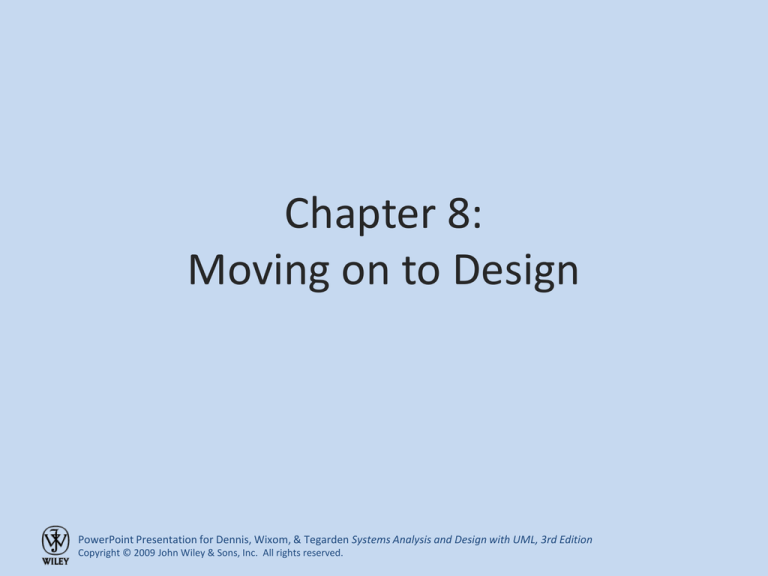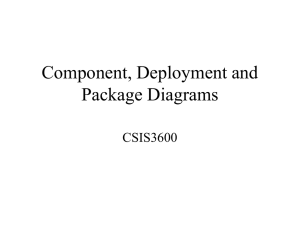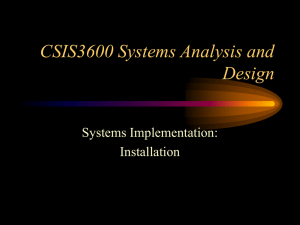
Chapter 8:
Moving on to Design
PowerPoint Presentation for Dennis, Wixom, & Tegarden Systems Analysis and Design with UML, 3rd Edition
Copyright © 2009 John Wiley & Sons, Inc. All rights reserved.
Objectives
• Understand the verification and validation of the
analysis models.
• Understand the transition from analysis to
design.
• Understand the use of factoring, partitions, and
layers.
• Be able to create package diagrams.
• Be familiar with the custom, packaged, and
outsource design alternatives.
• Be able to create an alternative matrix.
PowerPoint Presentation for Dennis, Wixom, & Tegarden Systems Analysis and Design with UML, 3rd Edition
Copyright © 2009 John Wiley & Sons, Inc. All rights reserved.
Key Ideas
• The purpose of the analysis phase is to figure
out what the business needs. The purpose of
the design phase is to figure out how to
provide it.
• The steps in both analysis and design phases
are highly interrelated and may require much
“going back and forth”
PowerPoint Presentation for Dennis, Wixom, & Tegarden Systems Analysis and Design with UML, 3rd Edition
Copyright © 2009 John Wiley & Sons, Inc. All rights reserved.
Avoiding Classic Design Mistakes
•
•
•
•
Reducing design time
Feature creep
Silver bullet syndrome
Switching tools in mid-project
PowerPoint Presentation for Dennis, Wixom, & Tegarden Systems Analysis and Design with UML, 3rd Edition
Copyright © 2009 John Wiley & Sons, Inc. All rights reserved.
VERIFYING AND VALIDATING (V&V)
THE ANALYSIS MODELS
PowerPoint Presentation for Dennis, Wixom, & Tegarden Systems Analysis and Design with UML, 3rd Edition
Copyright © 2009 John Wiley & Sons, Inc. All rights reserved.
Walkthroughs
• Peer reviews of models and diagrams created
during analysis
– Conducted by teams of analysts, designers, and
clients
– Main purposes:
• Test the fidelity of the models
• Uncover errors or faults
• Potential danger is that analysts be punished
for errors uncovered
PowerPoint Presentation for Dennis, Wixom, & Tegarden Systems Analysis and Design with UML, 3rd Edition
Copyright © 2009 John Wiley & Sons, Inc. All rights reserved.
Functional Model V&V
1. Events in Use Case descriptions should map to
activities in the Activity Diagram
2. Object node in an activity diagram must be
mentioned in Use Case descriptions
3. Sequential ordering within the Use Cases should
match ordering in Activity Diagram
4. There must be a one-to-one correspondence of Use
Cases in the Use Case Diagram and Use Case
descriptions.
PowerPoint Presentation for Dennis, Wixom, & Tegarden Systems Analysis and Design with UML, 3rd Edition
Copyright © 2009 John Wiley & Sons, Inc. All rights reserved.
Functional Model V&V (cont’d)
5. All actors listed in a use case description
must be portrayed on the use-case diagram
6. Include stakeholders listed in the use case
description as actors in the use-case diagram
7. All relationships listed in a use-case
description must be portrayed on a use-case
diagram
PowerPoint Presentation for Dennis, Wixom, & Tegarden Systems Analysis and Design with UML, 3rd Edition
Copyright © 2009 John Wiley & Sons, Inc. All rights reserved.
Structural Model V&V
1. Every CRC card should be associated with a
class on the class diagram
2. Responsibilities listed on the CRC card must
be operations in a class on a class diagram
3. Collaborators on the CRC card imply some
type of association on the class diagram
4. Attributes listed on CRC cards must be
attributes in a class on a class diagram
PowerPoint Presentation for Dennis, Wixom, & Tegarden Systems Analysis and Design with UML, 3rd Edition
Copyright © 2009 John Wiley & Sons, Inc. All rights reserved.
Structural Model V&V (cont’d)
5. Class attributes with a type that is another
class imply a relationship between classes
6. Relationships on the CRC cards must show up
on the class diagram
7. Use association classes only if the association
has unique attributes not on either class
PowerPoint Presentation for Dennis, Wixom, & Tegarden Systems Analysis and Design with UML, 3rd Edition
Copyright © 2009 John Wiley & Sons, Inc. All rights reserved.
Behavioral Model V&V
1. Actors & objects on sequence diagrams must be
included on communication diagrams
2. Messages on sequence diagrams require
associations on communications diagrams
3. Every message on a sequence diagram must appear
as a message on an association in the
corresponding communication diagram
4. Guard conditions messages in sequence diagrams
require equivalent guard conditions on the
corresponding communication diagrams
PowerPoint Presentation for Dennis, Wixom, & Tegarden Systems Analysis and Design with UML, 3rd Edition
Copyright © 2009 John Wiley & Sons, Inc. All rights reserved.
Structural Model V&V (cont’d)
5. The sequence number on message labels in
communications diagrams must correspond to the
top-down ordering of the messages being sent on
the sequence diagram
6. State machine transitions must be associated with a
messages on sequence & communication diagrams
7. All entries in a CRUD matrix imply a message being
sent between an actor or object and another
PowerPoint Presentation for Dennis, Wixom, & Tegarden Systems Analysis and Design with UML, 3rd Edition
Copyright © 2009 John Wiley & Sons, Inc. All rights reserved.
EVOLVING THE ANALYSIS MODELS
INTO DESIGN MODELS
PowerPoint Presentation for Dennis, Wixom, & Tegarden Systems Analysis and Design with UML, 3rd Edition
Copyright © 2009 John Wiley & Sons, Inc. All rights reserved.
Factoring
• Creating modules that account for similarities
and differences between units of interest
• New classes
– Generalization
– Aggregation
• Abstracting
• Refinement
PowerPoint Presentation for Dennis, Wixom, & Tegarden Systems Analysis and Design with UML, 3rd Edition
Copyright © 2009 John Wiley & Sons, Inc. All rights reserved.
Partitions and Collaborations
• Creating “subsystems” or larger units
• Grouping units that collaborate
• May have collaboration among units or
partitions
• The more messages or contracts between
objects, the more likely they are in the same
partition
PowerPoint Presentation for Dennis, Wixom, & Tegarden Systems Analysis and Design with UML, 3rd Edition
Copyright © 2009 John Wiley & Sons, Inc. All rights reserved.
Layers
• Consider system environment information to
help evolve the analysis model
• Model-view-controller (MVC) architecture
• Separating application logic from user
interface logic
PowerPoint Presentation for Dennis, Wixom, & Tegarden Systems Analysis and Design with UML, 3rd Edition
Copyright © 2009 John Wiley & Sons, Inc. All rights reserved.
5 Layers
•
•
•
•
•
Foundation
Problem Domain
Data Management
Human-Computer Interaction
Physical Architecture
PowerPoint Presentation for Dennis, Wixom, & Tegarden Systems Analysis and Design with UML, 3rd Edition
Copyright © 2009 John Wiley & Sons, Inc. All rights reserved.
PACKAGES AND PACKAGE
DIAGRAMS
PowerPoint Presentation for Dennis, Wixom, & Tegarden Systems Analysis and Design with UML, 3rd Edition
Copyright © 2009 John Wiley & Sons, Inc. All rights reserved.
Package
• A general construct that groups units together
• Used to reduce complexity of models
• A package diagram shows packages only
PowerPoint Presentation for Dennis, Wixom, & Tegarden Systems Analysis and Design with UML, 3rd Edition
Copyright © 2009 John Wiley & Sons, Inc. All rights reserved.
Package Diagram for 5 Layers
PowerPoint Presentation for Dennis, Wixom, & Tegarden Systems Analysis and Design with UML, 3rd Edition
Copyright © 2009 John Wiley & Sons, Inc. All rights reserved.
Building Package Diagrams
1. Set the context
2. Cluster classes together based on shared
relationships
3. Model clustered classes as a package
4. Identify dependency relationships among
packages
5. Place dependency relationships between
packages
PowerPoint Presentation for Dennis, Wixom, & Tegarden Systems Analysis and Design with UML, 3rd Edition
Copyright © 2009 John Wiley & Sons, Inc. All rights reserved.
DESIGN STRATEGIES
PowerPoint Presentation for Dennis, Wixom, & Tegarden Systems Analysis and Design with UML, 3rd Edition
Copyright © 2009 John Wiley & Sons, Inc. All rights reserved.
Custom Development
• Allows for meeting highly specialized
requirements
• Allows flexibility and creativity in solving
problems
• Easier to change components
• Builds personnel skills
• May tax firm’s resources
• May add significant risk
PowerPoint Presentation for Dennis, Wixom, & Tegarden Systems Analysis and Design with UML, 3rd Edition
Copyright © 2009 John Wiley & Sons, Inc. All rights reserved.
Packaged Software
•
•
•
•
Software already written
May be more efficient
May be more thoroughly tested and proven
May range from components to tools to whole
enterprise systems
• Must accept functionality provided
• May require change in how the firm does business
• May require significant “customization” or
“workarounds”
PowerPoint Presentation for Dennis, Wixom, & Tegarden Systems Analysis and Design with UML, 3rd Edition
Copyright © 2009 John Wiley & Sons, Inc. All rights reserved.
System Integration
• The process of combining packages, legacy
systems, and new software
• Key challenge is integrating data
• Write data in the same format
• Revise existing data formats
• Develop “object wrappers”
PowerPoint Presentation for Dennis, Wixom, & Tegarden Systems Analysis and Design with UML, 3rd Edition
Copyright © 2009 John Wiley & Sons, Inc. All rights reserved.
Outsourcing
•
•
•
•
•
•
Hire external firm to create system
May have more skills
May extend existing resources
Never outsource what you don’t understand
Carefully choose vendor
Prepare contract and payment style carefully
PowerPoint Presentation for Dennis, Wixom, & Tegarden Systems Analysis and Design with UML, 3rd Edition
Copyright © 2009 John Wiley & Sons, Inc. All rights reserved.
Selecting a Design Strategy
•
•
•
•
•
Business need
In-house experience
Project skills
Project management
Time frame
PowerPoint Presentation for Dennis, Wixom, & Tegarden Systems Analysis and Design with UML, 3rd Edition
Copyright © 2009 John Wiley & Sons, Inc. All rights reserved.
Selecting a Design Strategy
Use Custom
Development when…
Use a Packaged System
when…
Use Outsourcing when…
Business Need
The business need is
unique
The business need is
common
The business need is not
core to the business
In-house Experience
In-house functional and
technical experience
exists
In-house functional
experience exists
In-house functional or
technical experience does
not exist
Project Skills
There is a desire to build
in-house skills
The skills are not strategic
The decision to outsource
is a strategic decision
Project Management
The project has a highly
skilled project manager
and a proven
methodology
The project has a project
manager who can
coordinate vendor’s
efforts
The project has a highly
skilled project manager
at the level of the
organization that
matches the scope of the
outsourcing deal
Time frame
The time frame is flexible
The time frame is short
The time frame is short
or flexible
PowerPoint Presentation for Dennis, Wixom, & Tegarden Systems Analysis and Design with UML, 3rd Edition
Copyright © 2009 John Wiley & Sons, Inc. All rights reserved.
DEVELOPING THE ACTUAL DESIGN
PowerPoint Presentation for Dennis, Wixom, & Tegarden Systems Analysis and Design with UML, 3rd Edition
Copyright © 2009 John Wiley & Sons, Inc. All rights reserved.
The Alternative Matrix
• Combines several feasibility analyses into one
grid
• Revisits technical, economic, and
organizational feasibility
PowerPoint Presentation for Dennis, Wixom, & Tegarden Systems Analysis and Design with UML, 3rd Edition
Copyright © 2009 John Wiley & Sons, Inc. All rights reserved.
Request for Proposals
• Description of the system you propose to be
built
• Vendors, developers, service providers
respond with proposals including how they
will address needs as well as stating cost and
time requirements.
PowerPoint Presentation for Dennis, Wixom, & Tegarden Systems Analysis and Design with UML, 3rd Edition
Copyright © 2009 John Wiley & Sons, Inc. All rights reserved.
Summary
• Verifying and Validating the Analysis Models
• Evolving the Analysis Models into Design
Models
• Packages and Package Diagrams
• Design Strategies
• Developing the Actual Design
PowerPoint Presentation for Dennis, Wixom, & Tegarden Systems Analysis and Design with UML, 3rd Edition
Copyright © 2009 John Wiley & Sons, Inc. All rights reserved.





